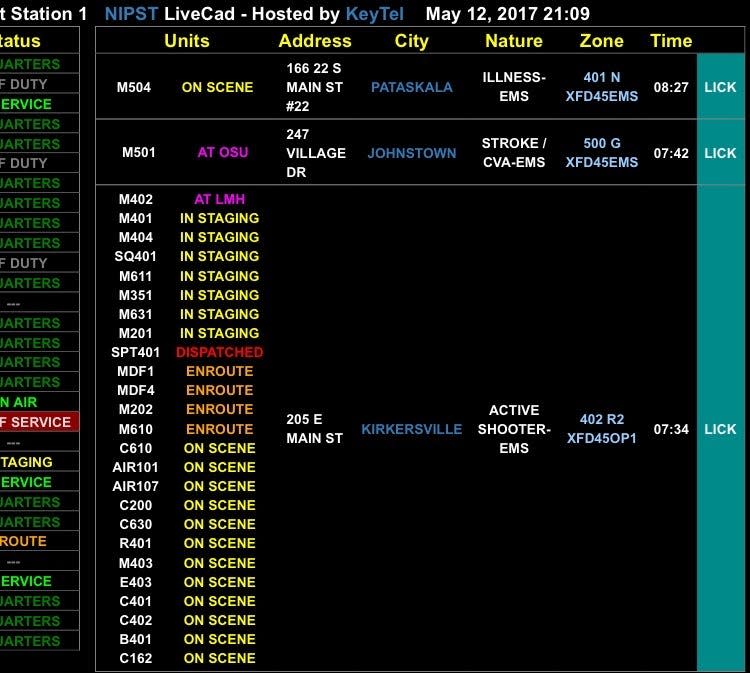Kirkersville shooting anniversary: Reporter Bethany Bruner recalls memories of scene
I wasn't supposed to be working on May 12, 2017.
When my phone rang around 7:45 a.m. that morning, I let it go to voicemail, but curiosity got the best of me. A few minutes later, I checked a website that allowed us to see where ambulances and fire trucks were responding in real time to see what was happening.
I never expected to see the words “active shooter.” I thought they were a joke. The entire drive to Kirkersville from my apartment in west Newark I thought I was going to get to the place that was best known for being a speed trap and it was going to turn out to be a “swatting.”
My first indication that this was no joke came when I passed National Trail Raceway. I saw two medical helicopters, their motors off. As someone who had been reporting on public safety in Licking County for four and a half years at that point, that told me either no one was hurt, or they were hurt so badly that flying them to a Columbus trauma center wouldn’t save them.
I knew which one I was hoping for.
I remember pulling onto Main Street and parking, getting out of my car and seeing more police vehicles in one place than I could ever remember seeing. I saw a line of sheriff’s deputies and police officers, in tactical formation, entering the Pine Kirk Care Center. I heard the radio traffic of what they found inside, and my blood turned cold.
Much of the day after that is a blur, but there are images and moments that stand out in my mind:

Seeing a FBI agent get out of a SUV, complete with the stereotypical dark sunglasses on an overcast day and the navy windbreaker with the bright yellow “FBI” on the back.
Watching the family of Cindy Krantz lose any hope that she would come out of her workplace alive as her body was brought out on a gurney and placed into a coroner’s office van.
Telling a coworker to move my car so it didn’t become part of the crime scene, asking for tissues because my nose was running — as trivial as it seemed at that moment — and for a phone charger because my battery wasn’t going to last the day.
I remember a week later, watching Aryn DiSario stand over her husband’s casket for the final time, knowing that 24 hours later, her labor would be induced to deliver the daughter he’d never meet. That image won’t ever leave my mind.
Also never leaving my mind will be the sounds and images from the dash camera footage of the first responding deputies to Pine Kirk. I watched that video multiple times for my reporting, just as I looked at the crime scene photographs. I listened as Deputy Nick Shuster begged Steven “Eric” DiSario, who had been chief of police for less than a month, to stay with him as Shuster desperately performed CPR in the back of another deputy’s cruiser as they headed for safety.
I remember talking to Shuster almost a year after the shooting for a story. He didn’t remember much of what happened after he got to the scene, his brain’s efforts to save him from constantly reliving the trauma.
I also remember talking with three of the employees inside Pine Kirk as they relived those horrifying moments. As they talked, you could see their minds traveling back in time to that moment, feel the fear in their voices. I hope they have found closure and healing.

After the shooting, when Pine Kirk was getting ready to reopen, I got a tour from the then owner. He and I walked the most likely path of the shooter, whose name I will not use, as he first took hostages in an alley behind Pine Kirk, shot DiSario, ran to the front of the building and shot his way inside. As I walked Pine Kirk’s halls, I saw the crime scene photos in my mind.
The voice of Marlina Medrano rings through my head sometimes as well. I had heard an audio recording she had made of a conversation with her estranged boyfriend, who would ultimately become the shooter that day. Hearing her laugh, knowing days later she would be dead … it was like listening to a ghost.
Five years later, hardly a day goes by that I don’t think about Kirkersville or the DiSario, Krantz and Medrano families. May 12, 2017, was a seminal moment in my reporting career. Covering a mass shooting is something I hope to never have to do again.
When I talk about that day, the first thing I mention — aside from the families and how often I think about them — is the feeling of unity. The Kirkersville community and the greater Licking County community surrounded the DiSario, Krantz and Medrano families with love and support. The lines at the funeral homes were long with people gathered to mourn those who were lost to a senseless act of violence.
Nobody hesitated to do what was needed that day. There were prayer vigils that packed a Kirkersville church, the people who created memorials outside the nursing home, those who raised money for the traumatized employees and the other nursing home facilities that took the residents who were displaced when their home was scarred by violence.
That should be the legacy of Kirkersville, as we remember what Eric DiSario, Cindy Krantz and Marlina Medrano embodied.
A legacy of service before self, of giving and caring for others and a reminder that nothing is guaranteed.
Bethany Bruner was the breaking news reporter for The Advocate during the Kirkersville shootings. She now covers Columbus Police and crime for The Columbus Dispatch.
Get more political analysis by listening to the Ohio Politics Explained podcast
This article originally appeared on Newark Advocate: Kirkersville mass shooting: Reporter recalls scene at nursing home

